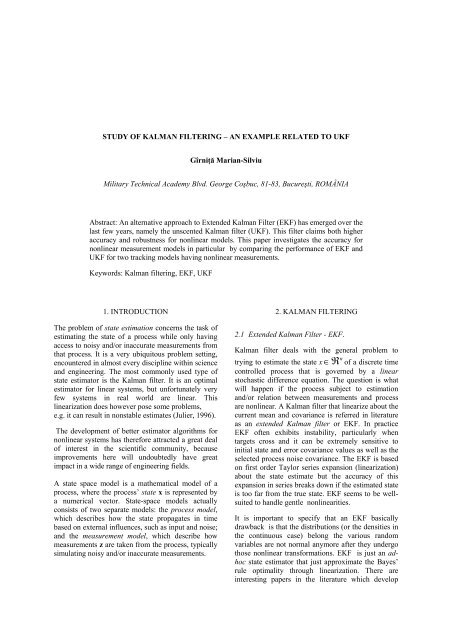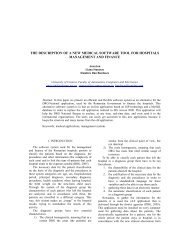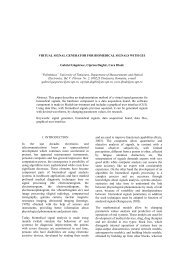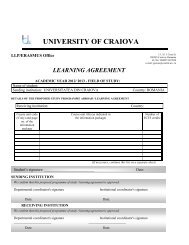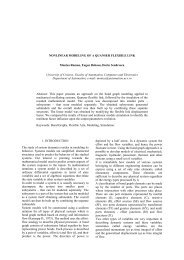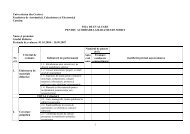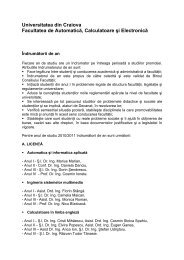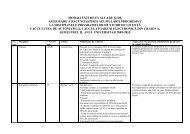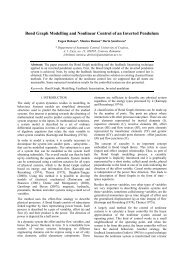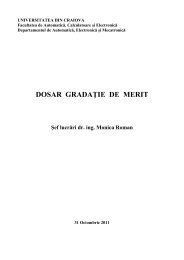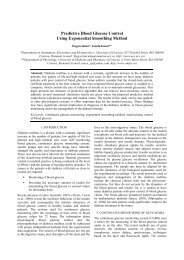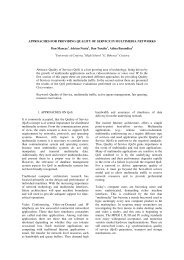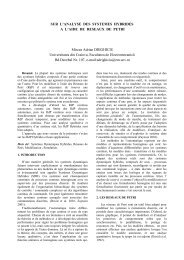THE TITLE OF THE PAPER, IN BOLD CAPITAL LETTERS, CENTRED,
THE TITLE OF THE PAPER, IN BOLD CAPITAL LETTERS, CENTRED,
THE TITLE OF THE PAPER, IN BOLD CAPITAL LETTERS, CENTRED,
Create successful ePaper yourself
Turn your PDF publications into a flip-book with our unique Google optimized e-Paper software.
STUDY <strong>OF</strong> KALMAN FILTER<strong>IN</strong>G – AN EXAMPLE RELATED TO UKF<br />
Gîrniţă Marian-Silviu<br />
Military Technical Academy Blvd. George Coşbuc, 81-83, Bucureşti, ROMÂNIA<br />
Abstract: An alternative approach to Extended Kalman Filter (EKF) has emerged over the<br />
last few years, namely the unscented Kalman filter (UKF). This filter claims both higher<br />
accuracy and robustness for nonlinear models. This paper investigates the accuracy for<br />
nonlinear measurement models in particular by comparing the performance of EKF and<br />
UKF for two tracking models having nonlinear measurements.<br />
Keywords: Kalman filtering, EKF, UKF<br />
1. <strong>IN</strong>TRODUCTION<br />
The problem of state estimation concerns the task of<br />
estimating the state of a process while only having<br />
access to noisy and/or inaccurate measurements from<br />
that process. It is a very ubiquitous problem setting,<br />
encountered in almost every discipline within science<br />
and engineering. The most commonly used type of<br />
state estimator is the Kalman filter. It is an optimal<br />
estimator for linear systems, but unfortunately very<br />
few systems in real world are linear. This<br />
linearization does however pose some problems,<br />
e.g. it can result in nonstable estimates (Julier, 1996).<br />
The development of better estimator algorithms for<br />
nonlinear systems has therefore attracted a great deal<br />
of interest in the scientific community, because<br />
improvements here will undoubtedly have great<br />
impact in a wide range of engineering fields.<br />
A state space model is a mathematical model of a<br />
process, where the process’ state x is represented by<br />
a numerical vector. State-space models actually<br />
consists of two separate models: the process model,<br />
which describes how the state propagates in time<br />
based on external influences, such as input and noise;<br />
and the measurement model, which describe how<br />
measurements z are taken from the process, typically<br />
simulating noisy and/or inaccurate measurements.<br />
2. KALMAN FILTER<strong>IN</strong>G<br />
2.1 Extended Kalman Filter - EKF.<br />
Kalman filter deals with the general problem to<br />
trying to estimate the state x∈ R n of a discrete time<br />
controlled process that is governed by a linear<br />
stochastic difference equation. The question is what<br />
will happen if the process subject to estimation<br />
and/or relation between measurements and process<br />
are nonlinear. A Kalman filter that linearize about the<br />
current mean and covariance is referred in literature<br />
as an extended Kalman filter or EKF. In practice<br />
EKF often exhibits instability, particularly when<br />
targets cross and it can be extremely sensitive to<br />
initial state and error covariance values as well as the<br />
selected process noise covariance. The EKF is based<br />
on first order Taylor series expansion (linearization)<br />
about the state estimate but the accuracy of this<br />
expansion in series breaks down if the estimated state<br />
is too far from the true state. EKF seems to be wellsuited<br />
to handle gentle nonlinearities.<br />
It is important to specify that an EKF basically<br />
drawback is that the distributions (or the densities in<br />
the continuous case) belong the various random<br />
variables are not normal anymore after they undergo<br />
those nonlinear transformations. EKF is just an adhoc<br />
state estimator that just approximate the Bayes’<br />
rule optimality through linearization. There are<br />
interesting papers in the literature which develop
EKF variations using methods that preserve the<br />
normal distributions passing through the nonlinear<br />
transformations.<br />
2.2 Unscented Kalman Filter – UKF.<br />
Let’s point out shortly the rough approximations of<br />
the EKF: EKF uses the first order terms from Taylor<br />
expansion; there are big errors when the models have<br />
strong nonlinearities; local linearity hypothesis is no<br />
more valid when higher order terms became<br />
significant. To eliminate these deficiencies it was<br />
looked for another approximation. The unscented<br />
transformation (UT) is a method for calculating the<br />
statistics of a random variable which undergoes a<br />
nonlinear transformation and builds on the principle<br />
that is easier to approximate a probability distribution<br />
than an arbitrary nonlinear function.<br />
The problem of UT transformation is to propagate x<br />
– an n x dimensional random variable – through a<br />
n n y<br />
nonlinear function g : R x a R to generate y :<br />
y = g( x)<br />
. The problem of propagating Gaussian<br />
random variables through a nonlinear function can<br />
also be approached using another technique, namely<br />
the unscented transform. Instead of linearizing the<br />
functions, this transform uses a set of points, and<br />
propagates them through the actual nonlinear<br />
function, eliminating linearization altogether. The<br />
points are chosed such that their mean, covariance,<br />
and possibly also higher order moments, match the<br />
Gaussian random variable. Mean and covariance can<br />
be recalculated from the propagated points, yielding<br />
more accurate results compared to ordinary function<br />
linearization. The underlying idea is also to<br />
approximate the probability distribution instead of<br />
the function. This strategy typically does both<br />
decrease the computational complexity, while at the<br />
same time increasing estimate accuracy, yielding<br />
faster, more accurate results.<br />
The underlying method of unscented transform was<br />
first proposed by Uhlmann; he laid out the<br />
framework for representing a Gaussian random<br />
variable in N dimensions using 2N +1 samples, called<br />
sigma points. He utilized the matrix square root and<br />
covariance definitions to selectthese points in such a<br />
way that he had the same covariance as the Gaussian<br />
they approximated. Skewness was avoided by<br />
selecting the points in a symmetric way, such that<br />
any approximation error would only originate from<br />
the fourth and higher moments. Usage of the<br />
unscented transform in Kalman filtering was then<br />
presented by Julier; he introduced the Unscented<br />
Kalman filter (UKF), which approximates the state<br />
estimate using sigma points.<br />
this bond are not guaranteed to yield positive<br />
semidefinite correlation matrices. This distance also<br />
increases with the dimension of the state space, a<br />
limitation that may cause problems in highly<br />
nonlinear models, since high sigma point spread may<br />
result in sampling of non-local features.<br />
The technique presented here is therefore based on<br />
the scaled unscented transform, which provides an<br />
additional tuning parmeter,α, compared to the<br />
original unscented transform. This parameter is used<br />
to arbitrary control the spread of the sigma-points,<br />
while at the same time guaranteeing positive<br />
semidefinite covariance matrices. Even models of<br />
high dimensonality can then keep a tight sigma point<br />
spread to avoid nonlocal effects.<br />
3. COMPARISON EKF-UKF<br />
The UKF compares favorably to the EKF in two<br />
other aspects as well. The UKF, like the EKF, forces<br />
the posterior density to be Gaussian, but the posterior<br />
mean and covariance are accurate to a third-order<br />
Taylor series expansion compared to first-order<br />
accuracy for the EKF. Finally, the UKF has the same<br />
order of computational complexity as the EKF. With<br />
these credentials, the UKF was expected to<br />
consistently outperform the EKF.<br />
The experiments described here aims at determining<br />
whether there are any difference between EKF and<br />
UKF for practical tracking applications, having linear<br />
process models and nonlinear measurement models.<br />
Fig.1. Illustration of how the Extended Kalman filter<br />
linearizes a nonlinear function around the mean<br />
of a Gaussian distribution, and thereafter<br />
propagates the mean and covariance through this<br />
linearized model<br />
Process Model. The basis for the experiment is an<br />
aeroplane, modelled linearly for position and<br />
velocity respectively, driven by white noise<br />
acceleration. The model<br />
p & x = vx<br />
, p&<br />
y = v y , v&<br />
x = ax<br />
, v&<br />
y = a y<br />
yields the following discrete time process model<br />
when assuming zero order hold with timestep Ts = 1.<br />
A limitation associated with the unscented Kalman<br />
filter is that it has a lower bound on the safe spread<br />
of the sigma points, meaning the distance between<br />
the points in state space. Sigma point spreads below
⎡ px<br />
⎤ ⎡1<br />
0 1 0 ⎤ ⎡ px<br />
⎤ ⎡ 0 ⎤<br />
⎢<br />
p<br />
⎥ ⎢ ⎥ ⎢<br />
y<br />
p<br />
⎥ ⎢ ⎥<br />
⎢ ⎥<br />
y<br />
⎢<br />
0 1 0 1 ⎢ ⎥ ⎢<br />
0<br />
⎥<br />
⎥<br />
⎢ v ⎥<br />
=<br />
+<br />
x ⎢0<br />
0 1 0⎥<br />
⎢ v ⎥<br />
x<br />
⎢ax<br />
⎥<br />
⎢ ⎥ ⎢ ⎥ ⎢ ⎥ ⎢ ⎥<br />
⎢ vy<br />
⎣ ⎦ ⎢ vy<br />
⎥ ⎢a<br />
⎣ ⎥⎦<br />
0 0 0 1<br />
y ⎥<br />
k + 1<br />
⎣ ⎦k<br />
⎣ ⎦k<br />
where the accelerations ax and ay are modelled as<br />
uncorrelated white noise with a variance of 0.5.<br />
Fig.2. Illustration of how the unscented Kalman filter<br />
propagates sigma-points from a Gaussian<br />
distribution through a nonlinear function, and<br />
recreates a Gaussian distribution, by calculating<br />
the mean and covariance of the results<br />
The process is assumed to start in the following state:<br />
x<br />
T<br />
0 = [ −200<br />
200 4 0] with the squared error metric<br />
( x − xˆ)<br />
T ( x − xˆ)<br />
for estimation accuracy.<br />
Tracking by Radar. Radar tracking can be modelled<br />
with a measurement model observing distance and<br />
angle to the target:<br />
⎡<br />
⎤<br />
⎡d<br />
2 2<br />
⎤ ⎢ p + ⎥ ⎡ ⎤<br />
=<br />
x p y n1<br />
⎢ ⎥<br />
+<br />
⎢<br />
⎥ ⎢ ⎥<br />
⎣Θ⎦<br />
⎣ 2 ⎦<br />
⎣<br />
arctg( p / p ) n<br />
y x ⎦<br />
where the measurement model is clearly nonlinear.<br />
The radar is assumed to be positioned in the<br />
coordinates (0,0) with measurement noises n1 and<br />
n1, having a variance of 200 and 0.003, respectively.<br />
Fig.3. Tracking of plane motion by means of<br />
triangulation<br />
Results. A simulation/estimation experiment was run<br />
10000 times. Each time, a simulated plane trajectory<br />
were estimated over 80 time steps, by both EKF and<br />
UKF for both of the observation models. The<br />
estimation accuracy results are shown in the table<br />
below, with accuracy distribution plots in the<br />
accompanying figure. The MSE estimate variance is<br />
calculated from the empirical error distribution, using<br />
formula: VAR(MSE) = VAR(eroare) / N.<br />
Table 1. Comparison EKF-UKF by MSE (Accuracy<br />
variance is given in parenthesis)<br />
Model MSE la EKF MSE la UKF<br />
Radar 174,4 (5,00) 116,9 (0,363)<br />
Triangulation 185,2 (3,15) 183,1 (2,81)<br />
The radar model, having measurements involving the<br />
highly nonlinear arcus-tangent, shows a wider<br />
difference in the estimation accuracy between EKF<br />
and UKF, compared to the triangulation model which<br />
only has Pythagoras’ measurements, being<br />
significantly more linear. It can further be seen that<br />
UKF seems to show a higher degree of robustness,<br />
having fewer estimates with errors above 1000 for<br />
both of the models. Graphical representation of the<br />
estimation error distribution proves that the two<br />
estimators produce similar results for both models<br />
(figure 5). Figure 6 illustrate UKF action mode with<br />
an arbitrary trajectory of a target.<br />
Fig.3. Tracking of plane motion by means of a radar<br />
Tracking by Triangulation. Tracking by triangulation<br />
can similarly be modelled with a measurement model<br />
observing distances to the target from two<br />
observators:<br />
⎡<br />
⎤<br />
⎢ −<br />
2<br />
+ −<br />
2<br />
⎡d<br />
⎤ ( p<br />
1 x p1x<br />
) ( p y p1y<br />
) ⎥ ⎡n1<br />
⎤<br />
⎢ ⎥ = ⎢<br />
⎥ + ⎢ ⎥<br />
⎣d2<br />
⎦ ⎢<br />
2<br />
2<br />
( − + − ⎥ ⎣n<br />
p p<br />
2 ⎦<br />
⎣ x 2x<br />
) ( p y p2y<br />
)<br />
⎦<br />
where the measurement model is also clearly<br />
nonlinear. The observators are assumed to be<br />
positioned in the coordinates (−300,0) and (300,0),<br />
with measurement noises n1 and n2, both having a<br />
variance of 200.<br />
Fig.5. EKF and UKF estimation errors in cases of<br />
radar and triangulation tracking
Fig.6. Example illustration of observations, true<br />
trajectory and estimated trajectory for the<br />
experiments using the UKF<br />
4. CONCLUSION<br />
This paper did therefore compare the relative<br />
estimation accuracy of UKF compared to EKF for<br />
linear state space models with nonlinear<br />
measurements. The relative advantage of using UKF<br />
does seem to increase with the degree of nonlinearity<br />
in the measurement model.<br />
REFERENCES<br />
Julier, S. and J. Uhlmann (1996). A general method<br />
for approximating nonlinear transformations<br />
of probability distributions, University of<br />
Oxford.<br />
Julier, S. (2002). The scaled unscented transform,<br />
Proceedings of the 2002 American Control<br />
Conference, IEEE Press.<br />
Julier, S. and J. Uhlmann (2004) Unscented filtering<br />
and nonlinear estimation, Proceedings of the<br />
IEEE.<br />
Van der merwe, R. (2003). Sigma-point Kalman<br />
filters for probabilistic inference in dynamic<br />
statespace models, Workshop on Advances in<br />
Machine Learning, Montreal.<br />
Wan, E. and R. Van der Merwe (2000). The<br />
Unscented Kalman Filter for nonlinear<br />
estimation, Proc. of IEEE Symposium 2000<br />
(AS-SPCC), Lake Louise, Alberta, Canada.


